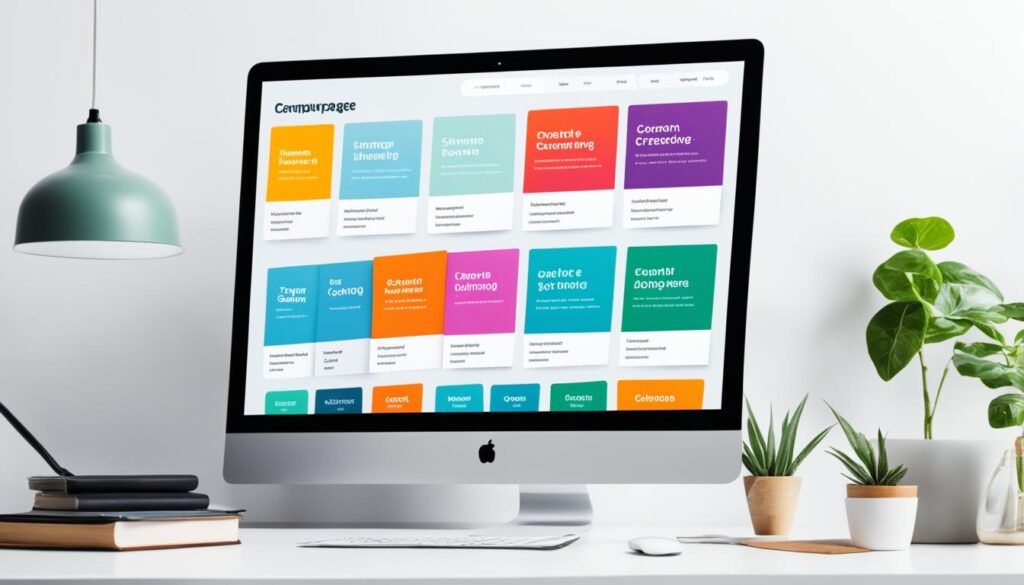Search Engine Optimization
Top Effective Keyword Research Techniques Unveiled

Were you aware that an astonishing 92% of internet journeys begin with a search engine? Indeed, it’s a fact! With such a remarkable figure, it’s clear that mastering effective keyword research methods is key to boosting your site’s visibility and attracting organic traffic. In this article, we will delve into keyword research strategies comprehensively, unveiling sophisticated techniques that will enhance your SEO tactics and set you apart in the digital realm.
Key Takeaways:
- Understanding your target audience is essential in identifying relevant keywords that resonate with their language and search preferences.
- Start with brainstorming seed keywords, broad terms that are directly related to your business or industry.
- Expand your keyword list using long-tail keywords, specific phrases that attract targeted traffic and have lower competition.
- Conduct competitor analysis to gain insights into successful keyword strategies and unlock new ideas.
- Take advantage of tools like Google Autosuggest and related searches to uncover additional keywords that users commonly search for.
Beyond these key takeaways, we will explore the importance of considering user intent, filtering and prioritizing keywords, as well as regularly reviewing and updating your keyword strategy to keep pace with evolving digital trends. Are you ready to supercharge your SEO efforts? Let’s dive in!
Understand Your Audience
Before diving into keyword research tools, it is crucial to understand your target audience and the language they use when searching for content related to your industry or niche. By gaining a deep understanding of your audience, you can identify relevant keywords that resonate with them and improve your search engine rankings.
When it comes to understanding your target audience, consider the following:
- Demographics: Determine the demographic characteristics of your audience, such as age, gender, location, and interests. This information can help you tailor your keywords to suit their preferences and needs.
- Pain points: Identify the challenges and pain points your audience may have. By addressing their specific needs in your keyword strategy, you can provide valuable solutions and position yourself as a trusted resource.
- Language: Pay attention to the language your audience uses when discussing your industry or niche. Are there any industry-specific terms or jargon they commonly use? Incorporating these words into your keyword strategy can help you speak their language and establish credibility.
“To effectively reach your target audience, you must speak their language and address their specific needs. Understanding their demographics and pain points will help you craft a keyword strategy that resonates with them.”
By understanding your target audience, you can create a keyword strategy that aligns with their needs and preferences. This not only improves your search engine rankings but also helps you attract high-quality traffic to your website.
Visualizing Your Target Audience
One way to understand your audience better is by creating customer personas. These personas represent your ideal customers and help you visualize their characteristics, preferences, and motivations.
Here’s an example of how a customer persona can look:
Name Age Location Interests Pain Points Emily 32 New York City Entrepreneurship, Fitness Struggling to increase online visibility for her fitness coaching business
Example customer persona
By creating detailed customer personas, you can develop a deeper understanding of your target audience and tailor your keyword strategy to their preferences and needs.
Brainstorm Seed Keywords
When embarking on the keyword research process, it’s important to start with a list of broad and general terms that are relevant to your business. These initial keywords, known as seed keywords, serve as the foundation for expanding your research further.
Let’s take the example of the digital marketing industry. Some seed keywords that could be brainstormed include “digital marketing,” “SEO,” and “social media.” These terms encompass the overarching topics and themes related to the industry.
“Digital marketing,” “SEO,” and “social media” are three seed keywords that can lay the groundwork for comprehensive keyword research in the digital marketing industry.
Seed keywords provide a starting point for exploring more specific and targeted keywords that will help optimize your website’s visibility in search engine results. By building upon these broad terms, you can uncover relevant long-tail keywords that capture the specific intent and interests of your audience.
As you brainstorm seed keywords, think about the broader terms that encapsulate your industry, products, or services. Focus on capturing the general ideas and concepts that form the basis of your business.
Once you have your list of seed keywords, you can then move on to expanding your research and discovering more opportunities for optimizing your website’s content and driving relevant organic traffic.
Examples of Seed Keywords in the Digital Marketing Industry:
- Digital marketing
- SEO
- Social media
- Content marketing
- Email marketing
- PPC advertising
Seed Keywords in Different Industries
| Industry | Seed Keywords |
|---|---|
| Health and fitness | Exercise, nutrition, weight loss, healthy living |
| Technology | Gadgets, software, tech news, electronics |
| Fashion | Clothing, style, trends, accessories |
| Finance | Investing, personal finance, budgeting, retirement planning |

Expand with Long-Tail Keywords
The process of expanding our keyword list involves identifying long-tail variations of the seed keywords we brainstormed earlier. Long-tail keywords are specific phrases that users are more likely to search for, and they can play a crucial role in driving targeted traffic to our website. To accomplish this, we turn to powerful keyword research tools like Google Keyword Planner, SEMrush, or Ahrefs.
Google Keyword Planner
Google Keyword Planner is a free tool provided by Google Ads that allows us to discover new keywords and get insights into keyword performance. By entering our seed keywords into the planner, we can generate a list of related keywords along with valuable metrics such as average monthly searches and competition levels. This information helps us identify long-tail variations that align with our target audience’s search intent.
SEMrush
SEMrush is a comprehensive SEO and keyword research tool that provides valuable data on organic and paid search. With SEMrush, we can explore our seed keywords and uncover long-tail variations that may have been overlooked. Additionally, SEMrush provides useful metrics like search volume, keyword difficulty, and competitive analysis, enabling us to make informed decisions about which keywords to prioritize.
Ahrefs
Ahrefs is another robust keyword research tool that provides valuable insights into search analytics, backlinks, and keyword rankings. Using Ahrefs, we can explore long-tail variations of our seed keywords, identify top-ranking pages for specific keyword queries, and gain a competitive edge. Its comprehensive database and advanced features make Ahrefs an excellent resource for expanding our keyword list.
“Long-tail keywords can attract more targeted traffic to our website, as they often have less competition.”
By utilizing these powerful keyword research tools, we can identify long-tail keywords that align with our target audience’s search intent. Incorporating these specific phrases into our website’s content will not only increase our chances of ranking higher in search engine results but also attract more targeted traffic to our website.

| Keyword Research Tool | Key Features |
|---|---|
| Google Keyword Planner | – Generates keyword ideas – Provides search volume data – Offers keyword performance insights – Free to use |
| SEMrush | – Explores organic and paid search – Offers keyword difficulty analysis – Provides competitive analysis – Wide range of SEO features |
| Ahrefs | – Provides search analytics and backlink insights – Uncovers top-ranking pages for keywords – Offers comprehensive keyword research tools – Advanced SEO features |
Competitor Analysis
When it comes to crafting a successful keyword strategy, understanding your competitors’ tactics is crucial. By conducting a thorough competitor analysis, we can gain valuable insights into the keywords they are targeting, which can inspire fresh ideas and improve our own keyword strategy.
To perform a competitor analysis, we recommend utilizing powerful SEO tools like SEMrush and Ahrefs. These tools provide detailed data and analytics on your competitors’ keyword rankings, search volume, and traffic sources.
By examining the keywords that are driving traffic to your competitors’ websites, you can identify lucrative opportunities to expand and refine your own keyword strategy. This analysis allows you to uncover untapped keyword niches, discover new long-tail keywords, and optimize your content to outrank your competition.
A competitor analysis not only helps you stay ahead of the game but also enables you to benchmark your performance against industry leaders. Analyzing their strategies, strengths, and weaknesses can provide valuable insights that inform your own keyword research and content planning.
“Good artists copy, great artists steal.”
– Pablo Picasso
Here’s a step-by-step guide on conducting a competitor analysis:
- Identify your top competitors in the industry.
- Use SEMrush or Ahrefs to analyze their organic keywords, ranking positions, and estimated traffic.
- Focus on keywords where your competitors rank high and you currently don’t.
- Uncover their content strategies and identify the types of content driving the most traffic.
- Identify patterns in their keyword usage and search intent focus to find opportunities for improvement.
With the information gathered from your competitor analysis, you can refine your keyword strategy to target high-performing keywords, optimize your content for search intent, and attract more organic traffic to your website.
Benefits of Competitor Analysis How It Helps Identify keyword gaps Discover and exploit keyword opportunities in your niche Uncover content gaps Create content that fills gaps your competitors may have missed Benchmark against industry leaders Understand where you stand in comparison to your competitors Stay ahead of trends Adapt your strategy to changes in the competitive landscape
By utilizing the wealth of information available through competitor analysis, you can gain a competitive edge in keyword research and develop a winning keyword strategy that drives relevant organic traffic to your website.

Use Google Autosuggest and Related Searches
When it comes to keyword research, Google’s autosuggest feature and related searches can be powerful tools to uncover additional keywords and gain deeper insights into user search behavior. By leveraging these features, we can expand our keyword list and optimize our content to align with the needs and preferences of our target audience.
To utilize Google Autosuggest, start by entering your seed keywords into the search bar. As you type, Google will provide a dropdown menu of suggested searches based on popular queries related to your keywords. Take note of these suggestions as they can reveal commonly searched terms that you may not have initially considered.
For example, let’s say we are a fitness blog aiming to attract organic traffic. By entering the seed keyword “weight loss tips” into the search bar, we can uncover a variety of autosuggest results such as “weight loss tips for women,” “weight loss tips for beginners,” and “weight loss tips at home.”
Furthermore, scrolling to the bottom of the search results page will show a section for related searches. These related searches provide additional keywords and topics that are closely associated with our seed keyword. They can offer valuable insights into the broader context and interests of our target audience.
Example:
Seed Keyword: Weight Loss Tips
Autosuggest Results:
– Weight Loss Tips for Women
– Weight Loss Tips for Beginners
– Weight Loss Tips at HomeRelated Searches:
– Weight Loss Meal Plans
– Weight Loss Exercises
– Weight Loss Supplements
By incorporating relevant autosuggest and related search keywords into our content strategy, we can optimize our website for a wider range of search queries, increase visibility, and attract more organic traffic.

Consider User Intent
Understanding user intent is a fundamental aspect of effective keyword research. By analyzing search queries and aligning keyword choices with user expectations, we can optimize our content to deliver the information, products, or services that users are actively seeking.
When considering user intent, it’s important to evaluate the purpose behind the search queries. Are users looking for informational content, intending to make a purchase, or seeking a specific service? By categorizing user intent, we can tailor our keyword strategy to align with these different search intents.
For example, let’s say our website offers a range of healthy recipes and cooking tips. We would want to target keywords that are aligned with user intent, such as “quick and nutritious dinner recipes,” “vegetarian meal ideas,” or “healthy baking alternatives.” These keyword choices ensure that our content addresses the specific needs and interests of users searching for recipe inspiration or guidance on implementing a healthy lifestyle.
By understanding user intent and aligning our content with relevant search queries, we can enhance the effectiveness of our keyword strategy. This improves the chances of our content appearing prominently in search engine results, attracting organic traffic from users actively seeking the information, products, or services we offer.

Examples of User Intent Categories
| User Intent | Keyword Examples |
|---|---|
| Informational | “How to lose weight,” “Benefits of meditation” |
| Transactional | “Buy iPhone online,” “Best price for Samsung TV” |
| Navigational | “Facebook login,” “YouTube homepage” |
| Commercial Investigation | “Compare iPhone vs. Android,” “Best budget laptops” |
| Local Search | “Restaurants near me,” “Hair salons in Chicago” |
Filter and Prioritize Keywords
Not all keywords hold equal value for a successful keyword strategy. To maximize our SEO efforts, it’s crucial to filter and prioritize keywords based on key metrics such as search volume, competition, and relevance. By striking a balance between high-search-volume keywords and those with less competition, we can optimize our website’s visibility and reach.
Let’s take a closer look at these metrics:
Keyword Metric Description Search Volume The number of searches a keyword receives in a given timeframe. Higher search volume implies greater potential traffic. Competition The level of competition for a particular keyword. Higher competition may make it more challenging to rank organically. Relevance The alignment between a keyword and the content on our website. Relevant keywords enhance user experience and improve search engine rankings.
By evaluating keywords based on these metrics, we can create a refined keyword list that targets our desired audience effectively. Let’s work towards constructing an optimized keyword strategy that drives organic traffic and boosts our online presence.
Example:
Search Volume: A keyword with high search volume indicates a higher demand for that particular topic or product. For instance, “best smartphones” might have a higher search volume compared to “rare collectible coins.”
Competition: Keywords with low competition provide an opportunity to rank higher in search engine results. For example, “best affordable beach vacations” might have lesser competition than “luxury beach resorts.”
Relevance: Ensuring our keywords closely align with the content we offer on our website is key to attracting the right audience. If our website focuses on pet care, using keywords like “dog grooming tips” or “cat health advice” would be highly relevant.
By applying this filtering and prioritization approach to our keyword research, we can refine our strategy and target the keywords that will have the greatest impact on our SEO efforts.

Regularly Review and Update
The digital landscape and search trends are constantly evolving, making it crucial for us to regularly review and update our keyword strategy. By staying abreast of changes in user behavior, industry trends, and search engine algorithms, we can ensure that our website remains optimized for maximum visibility and engagement.
One of the primary reasons for regularly reviewing and updating our keyword strategy is the dynamic nature of the digital landscape. New technologies, platforms, and online behaviors emerge all the time, influencing the way users search for information. By staying attuned to these shifts, we can adapt our keyword strategy to align with the latest search trends and better connect with our target audience.
Industry trends also play a significant role in determining the efficacy of our keyword strategy. As new ideas, products, and services emerge, the language and terminology used within the industry may change. By conducting regular keyword research and analysis, we can identify shifts in industry jargon and incorporate relevant keywords into our strategy to maintain relevance and resonate with our audience.
Search engine algorithms are constantly evolving as well, as search engines strive to provide the most relevant and valuable results to users. By reviewing and updating our keyword strategy, we can ensure that we are meeting the requirements and guidelines set by search engines, thereby maximizing our chances of ranking well in search results.
Regularly reviewing and updating our keyword strategy is an ongoing process that we must prioritize. It allows us to stay ahead of the competition, remain visible in the digital landscape, and adapt to the changing needs and behaviors of our target audience. By doing so, we can continue to drive organic traffic to our website and achieve our SEO goals.

Here’s a summary of why regular review and update of our keyword strategy are essential:
- Keep up with changes in user behavior and search trends
- Adapt to the evolving digital landscape
- Align with industry trends and language
- Stay updated with search engine algorithms
- Remain visible and competitive
- Drive organic traffic and achieve SEO goals
Conclusion
Mastering effective keyword research techniques is crucial for optimizing SEO efforts and driving organic traffic to websites. By conducting a data-driven analysis and understanding our audience, we can strategically choose keywords that resonate with our target users and improve our search engine rankings.
Regularly reviewing and updating our keyword strategy is essential in the ever-changing digital landscape. This ensures that we stay relevant to evolving user behavior and industry trends, and align our content with search engine algorithms.
By implementing these techniques, we can enhance our SEO efforts, attract organic traffic, and establish a strong connection with our audience. Keyword research is the foundation of a successful online presence, enabling us to effectively reach and engage our target users.
Keyword research is a crucial aspect of SEO that involves identifying and analyzing the terms or phrases that people use when searching for specific content or information online.
Keyword research is essential for SEO because it helps websites understand what terms their target audience is using when searching for content related to their industry or niche. This knowledge allows businesses to create relevant, optimized content that improves their visibility in search engine results and attracts organic traffic. Effective keyword research techniques include understanding the target audience, brainstorming seed keywords, expanding with long-tail keywords, analyzing competitors, using Google Autosuggest and related searches, considering user intent, filtering and prioritizing keywords, and regularly reviewing and updating the keyword strategy.
Understanding the target audience involves researching and identifying the language and terms they are likely to use when searching for content in your industry. This understanding helps in identifying relevant keywords that resonate with the audience and improve search engine rankings.
Seed keywords are broad, general terms that are relevant to your business or industry. These keywords act as a starting point for further keyword research and expansion.
Use keyword research tools like Google Keyword Planner, SEMrush, or Ahrefs to identify long-tail variations of your seed keywords. Long-tail keywords are specific phrases that users are likely to search for. They often have less competition and can attract more targeted traffic to your website.
Analyzing the keywords that competitors are targeting provides insights into the keywords driving traffic to their websites. This analysis can inspire new ideas for your own keyword strategy and help you identify potential gaps or opportunities in your industry. Utilize Google’s autosuggest feature by typing your seed keywords into the search bar and noting the suggested searches. Scroll to the bottom of the search results page to find related searches, which can unveil additional keywords commonly associated with your topic.
Understanding the intent behind user search queries is crucial for aligning keywords with user expectations. Consider whether users are searching for information, making a purchase, or seeking a specific service and ensure the keywords align with the intent to improve the effectiveness of your content.
Filter and prioritize keywords based on metrics like search volume, competition, and relevance. Strive for a balance between high-search-volume keywords and those with less competition to maximize your SEO efforts.
The digital landscape and search trends continually evolve. Regularly reviewing and updating your keyword strategy helps ensure it stays aligned with changes in user behavior, industry trends, and search engine algorithms. This will help you maintain relevance and effectiveness in your SEO efforts.
By adopting effective keyword research techniques, you can enhance your SEO efforts by attracting organic traffic, improving search engine rankings, and resonating with your target audience. This, in turn, can lead to increased visibility, website traffic, and potential conversions.FAQ
What is keyword research?
Why is keyword research important for SEO?
What are effective keyword research techniques?
How do I understand my audience for keyword research?
What are seed keywords?
How do I expand my keyword list with long-tail keywords?
How can competitor analysis help with keyword research?
How can I use Google Autosuggest and related searches for keyword research?
Why is user intent important in keyword research?
How do I filter and prioritize keywords for my strategy?
Why is it important to regularly review and update my keyword strategy?
How can effective keyword research techniques improve my SEO efforts?
Erik – Email, SEO, AI Expert Writer Erik is the strategist, the thinker, and the visionary. His role at Influenctor is pivotal in integrating SEO with AI-driven content strategies. With an extensive background in email marketing and a profound understanding of search engine algorithms, Erik develops innovative strategies that elevate our client’s online presence. His work ensures that our content is seen, felt, and remembered.
Search Engine Optimization
Checklist for Search Engine Optimization (SEO) in 2024

Introducing our thorough SEO checklist for 2024! Being specialists in search engine optimization, we recognize how critical it is to keep up with the most recent SEO techniques, superior methods, and advice for enhancing website visibility and rankings. Given the continuous evolution of search engines, having a comprehensive checklist for all things SEO is essential to make sure your website is optimized efficiently.
In this article, we will provide you with a detailed SEO checklist that encompasses on-page and off-page optimization, content writing, and leveraging Google tools. By following this checklist, you can take the necessary steps to enhance your website’s search engine performance and attract organic traffic.
Whether you’re a website owner or a digital marketer, this checklist will serve as a handy guide to implement SEO best practices and improve your online presence. Let’s dive into the key areas of SEO that you need to focus on in 2024!
Key Takeaways:
- Stay updated with the latest SEO techniques and best practices.
- Implement on-page and off-page optimization strategies.
- Craft SEO-optimized content to attract and engage users.
- Utilize Google tools to analyze, monitor, and improve SEO performance.
- Continuously update your SEO strategies to adapt to search engine algorithm changes.
What Is SEO and Why Do You Need a Checklist?
In the world of digital marketing, search engine optimization (SEO) plays a crucial role in improving website visibility and driving organic traffic. But what exactly is SEO, and why is it essential to have a checklist for implementing successful SEO strategies?
SEO refers to the practice of optimizing a website’s content, structure, and other elements to improve its visibility in search engine rankings. By optimizing your website for search engines, you can increase the chances of your target audience finding you when they search for relevant keywords.
So, why do you need a checklist for SEO?
Implementing effective SEO strategies can be a complex and time-consuming process. It involves various tasks, including keyword research, on-page optimization, off-page optimization, content creation, and technical SEO, among others. To ensure that you cover all the essential aspects of SEO and don’t miss any crucial steps, having a checklist is crucial.
Understanding the Basics of SEO
Before delving into the importance of using a checklist for SEO, it’s essential to understand the basics of SEO. SEO involves both on-page and off-page optimization techniques.
On-page optimization focuses on optimizing the elements within your website, such as page titles, meta descriptions, keywords, and user experience. Off-page optimization, on the other hand, involves building backlinks, engaging in social media, and managing online reviews and citations to increase your website’s authority and credibility.
Importance of Using a Checklist for SEO
Using a checklist for SEO ensures that you cover all the essential aspects of search engine optimization and follow best practices. Here are some reasons why having a checklist is crucial:
- Ensures comprehensive optimization: With a checklist, you can systematically go through all the necessary steps and ensure that you optimize every element of your website effectively.
- Minimizes the risk of overlooking important tasks: SEO involves numerous tasks, and it’s easy to miss crucial steps without a checklist. With a checklist in hand, you can rest assured that you’re not skipping any essential SEO strategies.
- Keeps your SEO efforts organized: A checklist helps you stay organized and maintain a clear roadmap for your SEO strategy. It ensures that you stay on track and accomplish each task efficiently.
- Saves time and effort: By following a checklist, you can streamline your SEO processes and optimize your website more efficiently, saving valuable time and effort.
Using a checklist for SEO allows you to implement a methodical approach to optimize your website and improve its search engine rankings. In the next sections of this article, we will provide you with a comprehensive SEO checklist that covers on-page optimization, off-page optimization, content writing, and the use of Google tools, helping you boost your website’s visibility and attract more organic traffic.
On-Page SEO Checklist – A Complete Guide
This section focuses on on-page SEO techniques and provides a comprehensive checklist for optimizing various on-page elements. By following this checklist, website owners can ensure that their web pages are optimized for search engines and provide a positive user experience.
Optimizing Page Titles
One of the most important on-page SEO factors is optimizing page titles. Make sure that each page has a unique and descriptive title that includes relevant keywords. Keep the title between 50-60 characters for better visibility in search engine results.
Improving Meta Descriptions
Meta descriptions are essential for providing a brief preview of the content on a web page. Aim for a concise and engaging description that accurately reflects the page’s content and includes relevant keywords. Keep the meta description between 150-160 characters.
Utilizing Keywords Effectively
Keywords play a crucial role in on-page SEO. Use relevant keywords naturally throughout the content, including in the headings, paragraphs, and image alt tags. Avoid keyword stuffing, and focus on providing valuable, informative content.
Enhancing User Experience
User experience (UX) is a vital factor in on-page SEO. Optimize your website’s design, layout, and navigation to ensure a seamless and enjoyable user experience. Improve page load speed, make the website mobile-friendly, and optimize for easy readability.
Implementing Technical SEO Best Practices
Technical SEO focuses on optimizing the technical aspects of a website for better search engine visibility. Ensure that your website has a clean and crawlable structure, is secure with HTTPS, has optimized URL structures, uses XML sitemaps, and has proper header tags.

| On-Page SEO Elements | Optimization Tips |
|---|---|
| Page Titles | Include relevant keywords in unique and descriptive titles. |
| Meta Descriptions | Create concise and engaging descriptions with relevant keywords. |
| Keywords | Use keywords naturally in headings, paragraphs, and image alt tags. |
| User Experience | Optimize design, layout, navigation, and page load speed for a seamless user experience. |
| Technical SEO | Ensure clean structure, HTTPS, optimized URLs, XML sitemaps, and proper header tags. |
Off-Page SEO Checklist – Boosting Your Website’s Authority
In addition to on-page optimization, off-page SEO plays a crucial role in improving your website’s authority and credibility in the eyes of search engines. By implementing the following checklist, you can enhance your website’s visibility in search engine rankings.
Creating Quality Backlinks

Backlinks are essential for establishing your website’s authority. Focus on building high-quality backlinks from reputable websites. These backlinks should be relevant to your niche and contain anchor text that includes your target keywords.
Utilizing Social Media for SEO
Social media platforms can be powerful tools for off-page SEO. Create engaging and shareable content that attracts your target audience. Encourage social media users to share your content, which can drive traffic to your website and increase its visibility.
Engaging in Guest Blogging
Guest blogging allows you to reach a wider audience and build valuable backlinks. Look for reputable websites in your industry that accept guest posts. Craft high-quality, informative articles that provide value to readers and include links back to your website.
Monitoring Online Reviews and Citations
Online reviews and citations play a significant role in your website’s authority and credibility. Regularly monitor and respond to online reviews, both positive and negative, to maintain a positive online reputation. Ensure that your business information is consistent and accurate across different online directories and citation sources.
Utilizing Local SEO Strategies
Local SEO is crucial for businesses targeting a specific geographic area. Optimize your website for local searches by including your location in page titles, meta descriptions, and content. Utilize Google My Business to manage your local listing and ensure that your business information is accurate and up to date.
Content Writing Checklist – Crafting SEO-Optimized Content
In order to create effective content that is optimized for search engines, it is important to follow a checklist. This checklist will guide you through the process of crafting SEO-optimized content that is tailored to meet the needs and preferences of your target audience.
Understanding Search Intent and Focused Content Creation
Before you start writing, it is crucial to understand the search intent behind the keywords you are targeting. By knowing what users are looking for when they search for those keywords, you can create content that provides valuable and relevant information. Focused content creation involves producing content that directly addresses the search intent and satisfies the user’s query.
Optimizing Content for Relevant Keywords
Keyword optimization plays a crucial role in SEO. By identifying relevant keywords and strategically incorporating them into your content, you can improve your website’s visibility in search engine results. Make sure to include keywords naturally and avoid keyword stuffing, as it can negatively impact your rankings.
Enhancing Readability and Engagement
Readable and engaging content is essential for keeping your audience interested and encouraging them to stay on your website. Use simple and concise language, break up text into short paragraphs, and utilize headings, subheadings, and bullet points to improve readability. Additionally, make your content engaging by using storytelling techniques, asking questions, and encouraging interaction.
Utilizing Multimedia and Visual Elements
Adding multimedia and visual elements to your content can greatly enhance its appeal and engagement. Incorporate relevant images, videos, infographics, and charts to make your content visually appealing and easier to understand. Visual elements can also help break up text and make your content more skimmable.

Implementing SEO Best Practices into Content Creation
When creating content, it is essential to follow SEO best practices. This includes optimizing your meta tags, using descriptive and keyword-rich headings and subheadings, incorporating internal and external links, and ensuring proper formatting with HTML tags. Pay attention to mobile optimization, site speed, and user experience to further enhance the performance of your content.
By following this content writing checklist and implementing SEO best practices, you can create high-quality content that is optimized for search engines, engages your audience, and improves your website’s visibility in search engine rankings.
| Content Writing Checklist | Benefits |
|---|---|
| Understanding Search Intent | Creates content that matches user expectations |
| Optimizing for Relevant Keywords | Improves search engine visibility |
| Enhancing Readability and Engagement | Keeps the audience interested and encourages interaction |
| Utilizing Multimedia and Visual Elements | Makes content visually appealing and easier to understand |
| Implementing SEO Best Practices | Optimizes content for search engines and enhances user experience |
Using Google Tools for SEO – Leveraging Resources for Success
In order to maximize the effectiveness of your SEO efforts, it’s crucial to leverage the power of Google tools. These tools offer valuable insights and resources that can help you enhance your website’s visibility and improve search engine rankings. In this section, we will explore some of the key Google tools that you can utilize to optimize your SEO strategy.
Utilizing Google Search Console for Website Analysis
Google Search Console is a powerful tool that provides comprehensive data about your website’s performance in Google search results. By analyzing this data, you can gain valuable insights into how your website is performing, identify any issues or errors that may be impacting your SEO, and make informed decisions to improve your website’s visibility. With Google Search Console, you can monitor keywords that are driving traffic to your site, track the number of impressions and clicks, identify crawling errors, and much more.
Harnessing the Power of Google Analytics for SEO Insights
Google Analytics is a must-have tool for any website owner or marketer. It provides detailed analytics and data about your website’s performance, user behavior, and traffic sources. By leveraging Google Analytics, you can gain valuable insights into how users are finding and interacting with your website. This information can help you identify areas for improvement, optimize your content strategy, and make data-driven decisions to enhance your SEO efforts. With Google Analytics, you can track organic search traffic, measure conversions, identify high-performing pages, and much more.
Enhancing Local Visibility with Google Business Profile
If you have a local business, optimizing your presence on Google Business Profile is crucial for local SEO. Google Business Profile allows you to create a comprehensive listing that includes important information such as your business name, address, phone number, website, and reviews. By optimizing your Google Business Profile, you can enhance your local visibility, appear in relevant local search results, and attract more customers to your business.

Maximizing the Benefits of Yoast SEO Plugin
Yoast SEO is a popular WordPress plugin that provides a wide range of SEO optimization features. With Yoast SEO, you can optimize your website’s meta tags, create SEO-friendly content, generate XML sitemaps, analyze readability scores, and much more. This plugin offers a user-friendly interface and actionable recommendations to improve your website’s SEO performance. By leveraging the features of Yoast SEO, you can ensure that your website meets the necessary SEO requirements and achieves better search engine rankings.
Conducting Comprehensive Keyword Research Checklist
Keyword research is a critical component of any SEO strategy. By conducting comprehensive keyword research, you can identify the most relevant and high-performing keywords for your website or content. This will help you optimize your content, target the right audience, and improve your website’s visibility in search engine results. Use tools like Google Keyword Planner, SEMrush, or Moz to conduct keyword research and uncover valuable insights about search volume, competition, and user intent.
Conclusion
In conclusion, having an effective SEO checklist is crucial for website optimization and improving search engine rankings. By following the checklist provided in this article, website owners and marketers can ensure that they cover all the essential aspects of SEO and increase their website’s visibility.
Implementing the checklist involves optimizing on-page elements, such as page titles and meta descriptions, and enhancing user experience through effective keyword utilization and technical SEO best practices. It also entails boosting website authority through off-page techniques, including quality backlink creation, social media engagement, and guest blogging.
Additionally, the content writing checklist emphasizes the importance of crafting SEO-optimized content by understanding search intent, utilizing relevant keywords, and enhancing readability and engagement through multimedia elements. Utilizing Google tools, such as Google Search Console and Google Analytics, further enhances SEO performance by providing valuable insights and data.
We encourage readers to implement the checklist and continually update their SEO strategies to stay ahead in the ever-evolving landscape of search engine optimization. By doing so, website owners and marketers can effectively improve their website’s search engine rankings and visibility, resulting in increased organic traffic and business success.
SEO, or search engine optimization, is the practice of optimizing a website to improve its visibility and rankings on search engine results pages. Having a checklist for SEO is essential because it ensures that all necessary steps are taken to optimize a website effectively and improve its chances of ranking higher in search results. The on-page SEO checklist covers various elements that can be optimized on a webpage to improve its search engine rankings. It includes optimizing page titles, improving meta descriptions, utilizing keywords effectively, enhancing user experience, and implementing technical SEO best practices.
The off-page SEO checklist focuses on strategies that can boost a website’s authority and credibility. It includes creating quality backlinks, utilizing social media for SEO, engaging in guest blogging, monitoring online reviews and citations, and implementing local SEO strategies.
The content writing checklist includes guidelines for crafting SEO-optimized content. It covers topics such as understanding search intent and creating focused content, optimizing content for relevant keywords, enhancing readability and engagement, utilizing multimedia and visual elements, and implementing SEO best practices into content creation.
The Google tools checklist focuses on leveraging resources such as Google Search Console, Google Analytics, Google Business Profile, Yoast SEO plugin, and comprehensive keyword research. It provides guidance on how to utilize these tools effectively for SEO success.
FAQ
What is SEO and why do you need a checklist?
What does the on-page SEO checklist cover?
What does the off-page SEO checklist focus on?
What does the content writing checklist include?
What does the Google tools checklist cover?
What is SEO and why is it important?
SEO, or Search Engine Optimization, is the practice of improving the quantity and quality of traffic to a website through organic search engine results. It is important because it helps websites rank higher in search results, making them more visible to potential visitors.
What are the basics of SEO?
The basics of SEO involve keyword research, on-page optimization, technical optimization, content creation, and link building to improve a website’s visibility and ranking on search engines.
Why is technical SEO important?
Technical SEO focuses on optimizing the infrastructure of a website to make it easier for search engines to crawl and index the site. It includes aspects such as site speed, mobile-friendliness, site architecture, and structured data markup.
What are the key elements of technical SEO checklist?
The key elements of a technical SEO checklist include website speed optimization, mobile responsiveness, improving website architecture, implementing structured data markup, and fixing crawl errors.
How can I optimize my content for SEO?
You can optimize your content for SEO by conducting keyword research, creating high-quality and relevant content, optimizing meta tags, headings, and images, and ensuring proper internal linking within your website.
What is the significance of link building in SEO?
Link building is an important aspect of SEO that involves acquiring hyperlinks from other websites to your own. It helps to improve a website’s authority, trustworthiness, and visibility in search engine results.
How can I improve my website’s ranking in Google search results?
To improve your website’s ranking in Google search results, focus on creating valuable and relevant content, building high-quality backlinks, optimizing your website for mobile and technical performance, and adhering to Google’s webmaster guidelines.
What are the common SEO problems that website owners encounter?
Common SEO problems include slow website speed, poor mobile optimization, duplicate content, lack of quality backlinks, thin content, and technical issues that hinder search engine accessibility.
How can I check if my website’s SEO is up to par?
You can use tools like Google Search Console, Google Analytics, and SEMrush’s On-Page SEO Checker to conduct an SEO audit and identify areas for improvement on your website.
Why do I need a comprehensive SEO checklist?
A comprehensive SEO checklist helps you ensure that you have covered all the necessary aspects of SEO, including technical optimizations, content creation, link building, and monitoring the performance of your website, to improve its visibility and ranking in search results.
What SEO strategies should be implemented for a new website setup in 2024?
When planning a new website setup in 2024, it is crucial to follow a comprehensive new website setup checklist to ensure success. Incorporating SEO strategies such as keyword research, optimizing page load speed, and creating quality, relevant content can help the website rank higher in search engine results.
Source Links
- https://backlinko.com/seo-checklist
- https://searchengineland.com/seo-strategy-checklist-2024-436400
- https://thriveagency.com/news/the-ultimate-seo-checklist-for-2024/
Natali – Editor in Chief (Strategy and Mastery, AI Expert) Natali, our Editor in Chief, is the driving force behind our content’s strategic direction. With a keen eye for detail and a deep understanding of market trends, Natali ensures that our content is top-notch and strategically aligned with our client’s goals. Her expertise in AI helps to seamlessly integrate advanced technology into our marketing strategies, pushing the boundaries of conventional marketing.
Search Engine Optimization
50 Best Landing Page Design Tips for High Conversion

Welcome to our in-depth tutorial on landing page design tips for achieving high conversion rates. In the fiercely competitive realm of digital marketing, the key to effectively attracting leads and turning them into devoted customers lies in having a landing page that’s crafted with precision. Whether you’re launching a startup or you’re an experienced marketing professional, enhancing your landing pages can greatly increase your conversion rates, promoting the growth of your enterprise. In this guide, we’re going to dive into the top 10 landing page design tips that will equip you with the knowledge to develop landing pages with high conversion potential, thereby refining your digital marketing efforts.
By implementing these proven techniques, you will be able to create landing pages that inspire trust, engage your target audience, and increase your chances of converting visitors into customers. From understanding the elements of a good landing page to designing compelling copy and effective call-to-action buttons, we have got you covered. So, let’s dive in and discover how to revolutionize your landing page design!
Key Takeaways:
- Optimizing your landing page design is crucial for achieving high conversion rates.
- Understanding the elements of a good landing page is essential for creating an effective design.
- Designing compelling copy and implementing effective call-to-action strategies are key to driving conversions.
- Offering free trials on landing pages can boost conversions and entice visitors to take action.
- Implementing best practices and analyzing landing page metrics are essential for continuous improvement.
50 Quick Tips for A Landing Page that Sells
- Avoid sending targeted traffic directly to your website; instead, utilize a landing page.
- Ensure the landing page has a singular, focused purpose and message.
- Align every element on the landing page with its theme and goal.
- Segment traffic by source (e.g., PPC ads, emails, social media, organic search, banner ads) and direct to distinct landing pages for better tracking and performance analysis.
- Segment offers by customer demographic, like not sending women’s perfume promotions to male customers.
- Determine the optimal length for your landing page to provide sufficient information for customer action, balancing between too short and too long.
- Match the main headline of your landing page with the advertisement that led the customer there.
- Use a clear, direct headline on the landing page, treating it as an advertisement for the advertisement.
- Prioritize important points at the beginning of the landing page.
- Place key elements within the top 300 pixels of the landing page.
- Eliminate all navigation elements except for the order button.
- Write in the second person, using “you” and “your” instead of “we” and “our.”
- Focus on clear, persuasive messaging rather than attempting to impress with creativity or clever wording.
- Use bullet points to make text easier to read.
- Edit for conciseness and remove unnecessary content.
- Show the product or service in its relevant context.
- Consider using video to potentially boost conversions by up to 80%.
- Incorporate real customer stories to enhance credibility.
- Offer free samples or trials for a try-before-you-buy experience.
- Provide a guarantee to minimize customer risk.
- For digital products (e.g., ebooks, software), offer previews to build trust and demonstrate product quality.
- Use directional cues (like arrows or images of people pointing) to draw attention to the order button.
- For longer landing pages, ensure directional cues guide users towards the order button below the fold.
- Create a prominent order button placed above the fold.
- Place a compelling message near the order button.
- Display a contact phone number to establish trust and real-person contact.
- Employ A/B testing to evaluate different messaging strategies based on customer preferences.
- Optimize for Mobile Devices: Ensure your landing page is responsive and looks great on smartphones and tablets.
- Use High-Quality Images: Incorporate professional, high-resolution images that are relevant to your product or service.
- Implement Fast Load Times: Optimize the page for quick loading to reduce bounce rates.
- Add Social Proof: Showcase customer testimonials, reviews, ratings, or media mentions to build trust.
- Keep Forms Simple: If using forms, make them easy to fill out with minimal required fields.
- Use Contrasting Colors: Ensure your call-to-action (CTA) button and key elements stand out with contrasting colors.
- Implement SEO Best Practices: Optimize your landing page for search engines with relevant keywords, meta descriptions, and alt text for images.
- Include Trust Badges: Display security badges, association memberships, or awards to enhance credibility.
- Offer Multiple Contact Options: Besides a phone number, include an email address, contact form, or live chat feature.
- Use White Space Effectively: Don’t clutter the page; use white space to make content easily digestible.
- Add a FAQ Section: Address common questions or concerns to preempt customer queries.
- Implement Exit-Intent Popups: Gently prompt users who are about to leave the page with a special offer or reminder.
- Track and Analyze Visitor Behavior: Use tools like Google Analytics to understand how users interact with your page and make data-driven improvements.
- Regularly Update Content: Keep your landing page fresh and relevant with regular updates.
- Align with Overall Branding: Ensure your landing page is consistent with your brand’s style, tone, and messaging.
- Use Psychological Triggers: Incorporate elements of urgency (like limited time offers) or exclusivity to encourage quicker decision-making.
- Optimize Headline and Subheadings: Make them compelling, clear, and reflective of the page’s value proposition.
- Include a Clear Value Proposition: Explain clearly and concisely why someone should take the desired action.
- Test Different Variations: Regularly test different versions of headlines, CTAs, images, and other elements to see what works best.
- Use Clear Progress Indicators: For multi-step processes, show users where they are and how much is left.
- Keep Brand Consistency Across Campaigns: Ensure your landing page aligns with the messaging and design of your ads or emails.
- Add a Privacy Statement: Reassure visitors that their personal information is safe and will not be misused.
- Regularly Back Up Your Landing Page: To prevent data loss and ensure you can quickly restore your page in case of technical issues.
Understanding What Makes a Good Landing Page
In order to create a successful online marketing campaign, it is essential to understand the key elements that make a landing page effective. A landing page is a specific web page that is designed to capture visitor information and convert them into leads or customers. Let’s explore the definition of a landing page and its role in digital marketing, as well as best practices for designing a high-converting landing page and common mistakes to avoid.
Defining a Landing Page
A landing page is a standalone web page that visitors are directed to after clicking on a specific call-to-action (CTA), such as an ad, social media post, or email link. Unlike other pages on your website, a landing page has a singular focus: to drive conversions. It is designed to capture visitor information, such as their name and email address, in exchange for an offer, such as a free download, discount coupon, or webinar registration.
The Role of Landing Page in Digital Marketing
Landing pages play a crucial role in digital marketing campaigns. They act as the first point of contact between your business and potential customers, providing an opportunity to make a strong impression and drive desired actions. A well-designed landing page can significantly increase conversion rates and ultimately contribute to the growth and success of your business.
Product or Service Presentation in a Landing Page
When designing a landing page, it is important to present your product or service in a compelling and persuasive way. This includes showcasing the unique value proposition, highlighting key features and benefits, and providing visual elements such as images or videos that engage and capture the attention of visitors. A good landing page should clearly communicate the value your product or service offers and convince visitors to take the desired action.
Key Best Practices for a Best Landing Page Design
To create a highly effective landing page, there are several best practices you should follow:
- Keep the design clean and clutter-free to enhance readability and focus on the main message.
- Create a clear and compelling headline that grabs the visitor’s attention.
- Include persuasive and concise copy that clearly communicates the benefits of your offer.
- Use high-quality visuals to support your message and make the landing page visually appealing.
- Optimize the landing page for mobile devices to ensure a seamless user experience.
Common Landing Page Mistakes That Hurt Conversion Rates
While designing a landing page, it’s important to be aware of common mistakes that can negatively impact conversion rates. Avoid these pitfalls to ensure your landing page is optimized for success:
- Having a cluttered design that overwhelms visitors and distracts from the main message.
- Using vague or confusing headlines that fail to clearly communicate the purpose of the landing page.
- Providing too much information and overwhelming visitors with excessive text.
- Having a weak or unclear call-to-action that doesn’t entice visitors to take the desired action.
- Not optimizing the landing page for speed, resulting in slow loading times that discourage visitors from staying on the page.
By understanding these best practices and avoiding common mistakes, you can create landing pages that capture your audience’s attention, engage them with compelling content, and drive conversions. The next section will guide you through the step-by-step process of creating a landing page that converts.
How to Create a Landing Page That Converts
In this section, we will discuss the step-by-step process of creating a landing page that converts. We understand the importance of a well-designed landing page in driving conversions and maximizing the success of your marketing campaigns. By following these guidelines, you can create landing pages that effectively engage your audience and inspire them to take action.
Selecting the Right Landing Page Builder
Choosing the right landing page builder is crucial to the success of your campaign. With so many options available, it can be overwhelming to make the right choice. Look for a landing page builder that offers customizable templates, intuitive drag-and-drop functionality, and seamless integration with your email marketing and CRM tools. Consider factors such as ease of use, flexibility, and the availability of advanced features like A/B testing and analytics.
Designing a Landing Page: The Template Selection
The design of your landing page plays a significant role in its success. Start by selecting a visually appealing and user-friendly template that aligns with your brand and campaign objectives. Opt for clean layouts, clear typography, and high-quality images. Use contrasting colors strategically to draw attention to key elements such as headlines and call-to-action buttons. Remember to keep the design consistent with your overall branding to provide a seamless user experience.
Making Your Landing Page Copy Convert
The copy on your landing page is essential in conveying your message and convincing visitors to take action. Craft compelling headlines that grab attention and clearly communicate the value proposition of your offer. Keep the content concise, focused, and benefit-driven. Use bullet points to highlight the key features and benefits of your product or service. Incorporate persuasive language and customer testimonials to build trust and reinforce the value of your offer.
Effective Call To Action (CTA) Tips for Landing Pages
A well-crafted call-to-action (CTA) is crucial in driving conversions on your landing page. Use strong, action-oriented language that compels visitors to take the desired action. Place your CTA prominently on the page and make it visually appealing and easy to locate. Use contrasting colors and a button design that stands out. Consider using persuasive copy and urgency elements like limited-time offers to create a sense of urgency and encourage immediate action.
Create Landing Pages That Offer Free Trials
Offering free trials on your landing pages can be an effective strategy to boost conversions. Free trials give potential customers the opportunity to experience your product or service firsthand, eliminating barriers to purchase. Highlight the benefits of your free trial and make it easily accessible on your landing page. Consider using a lead capture form to gather contact information before granting access to the trial, enabling you to follow up with interested prospects and nurture leads.
Best Practices and Landing Page Design Tips
In this section, we will dive deeper into the best practices and design tips that can enhance your landing page’s effectiveness. Implementing these strategies will not only boost conversion rates but also create a positive user experience, ultimately leading to higher customer engagement and sales.
One of the Best Ways to Boost Conversion Rates
When it comes to boosting conversion rates, one of the most effective techniques is optimizing your landing page for mobile devices. With the increasing use of smartphones and tablets, it is crucial to ensure that your landing page is responsive and mobile-friendly. This means that it should adapt seamlessly to different screen sizes and resolutions, providing a smooth and enjoyable browsing experience for mobile users.
To achieve this, prioritize simplicity in your landing page design. Keep the layout clean and uncluttered, with easy-to-read fonts and clear navigation. Minimize the number of form fields and make sure they are easy to fill out on smaller screens. By optimizing for mobile, you can capture the attention of a wider audience and maximize your conversion potential.
Good Landing Page Design Best Practices
Creating a visually appealing and user-friendly landing page is essential for attracting and retaining visitors. Here are some best practices to keep in mind:
- Keep the design consistent: Use consistent branding elements, such as colors, fonts, and imagery, to create a cohesive and professional look.
- Use high-quality visuals: Images and videos should be relevant, engaging, and high-resolution. They should also load quickly to prevent user frustration.
- Create compelling headlines and subheadings: Grab the visitor’s attention with persuasive headlines and concise subheadings that clearly communicate the value proposition.
- Utilize white space: White space helps to improve readability and highlights the important elements on your landing page. Avoid clutter and overcrowding.
- Include a strong call-to-action (CTA): Your CTA should be prominent, visually appealing, and clearly convey the desired action you want visitors to take.
The Power of Thank You Pages
Thank you pages play a crucial role in the overall user experience and can significantly impact conversion rates. These pages are displayed after a visitor completes a desired action, such as submitting a form or making a purchase.
Thank you pages present a valuable opportunity to further engage and convert your audience. They can provide additional information, offer exclusive content or discounts, or encourage visitors to explore other areas of your website. By leveraging the power of thank you pages, you can build trust, nurture customer relationships, and encourage repeat visits.
When designing your thank you page, consider the following:
- Express appreciation: Use personalized messaging to thank visitors for their action and express gratitude for their interest in your product or service.
- Offer additional value: Provide relevant resources or exclusive offers that can enhance their experience and incentivize further engagement.
- Encourage social sharing: Include social sharing buttons to encourage visitors to share their positive experience with their networks, amplifying your reach.
- Guide visitors to the next step: Clearly communicate the next steps and guide visitors towards the desired conversion goal, whether it’s exploring related products or signing up for a newsletter.

By incorporating these best practices and design tips into your landing page strategy, you can optimize your conversions, enhance user experience, and drive business growth.
Why the Landing Page Should Be a Standalone
In this section, we will examine why it is beneficial to have a standalone landing page rather than incorporating it into your website. A standalone landing page is a dedicated page that focuses solely on promoting a specific product, service, or offer. Unlike a website, which may have multiple pages and distractions, a standalone landing page provides a focused and streamlined experience for your visitors.
By using a standalone landing page, you can create a tailored and targeted message that aligns with the specific needs and interests of your audience. This allows you to deliver a more impactful and persuasive message, increasing the likelihood of conversions.
One of the main advantages of a standalone landing page is that it eliminates distractions. Your visitors won’t be tempted to click away or navigate to other sections of your website. Instead, they can fully concentrate on your offer and the desired action you want them to take, such as making a purchase or filling out a form.
A standalone landing page also provides better tracking and analytics capabilities. Since it is separate from your main website, you can easily monitor the performance of your landing page and gather valuable data to optimize its effectiveness. This data includes metrics such as conversion rates, bounce rates, and engagement levels.
Additionally, a standalone landing page allows for easy A/B testing and experimentation. You can test different elements, such as headlines, colors, images, and call-to-action buttons, to find the most effective combination that resonates with your audience. This helps you refine and improve your landing page over time.
How Many Landing Pages Do You Need?
The number of landing pages you need depends on your specific marketing goals and the diversity of your offerings. It is recommended to create separate landing pages for each distinct product, service, or offer you want to promote.
By having multiple landing pages, you can effectively target different segments of your audience and cater to their specific needs. Each landing page can be optimized with relevant keywords, unique value propositions, and tailored messaging, ensuring a more personalized experience for your visitors.
Creating multiple landing pages also allows you to track and measure the performance of each page individually. This way, you can identify which landing pages are driving the most conversions and optimize them accordingly to maximize your overall conversion rate.
However, it’s important to find the right balance. Having too many landing pages can be overwhelming and difficult to manage, especially if you have limited resources. It’s crucial to prioritize your offerings and focus on creating high-quality landing pages for your most important products or services.
Decoding The High Converting Landing Pages
In this section, we will unravel the secrets of high-converting landing pages and provide you with valuable insights to increase your landing page conversion rates. Understanding the elements that contribute to the success of a landing page is crucial for achieving your marketing goals.
Elements of High Converting Landing Pages
A high-converting landing page is crafted strategically to capture attention, engage visitors, and encourage them to take action. Here are some essential elements to consider:
- Compelling Headline: Your headline should be attention-grabbing and clearly communicate the value proposition.
- Clear Call-to-Action (CTA): Your CTA should be prominently displayed and use persuasive language to encourage visitors to take the desired action.
- Engaging Visuals: Images and videos that are relevant to your offer can help to capture the visitor’s attention and make your landing page more visually appealing.
- Concise and Persuasive Copy: Use clear and concise copy to communicate the benefits of your offer and address any potential objections.
- Trust Factors: Include testimonials, reviews, or trust badges to build credibility and trust with your audience.
- Mobile-Friendly Design: With the increasing use of mobile devices, it’s essential to ensure your landing page is optimized for mobile viewing to capture a larger audience.
By incorporating these elements into your landing page design, you can create a high-converting landing page that drives results.
Why Your Landing Page Doesn’t Convert: Common Problems
While a well-designed landing page can generate significant conversions, there are common problems that can hinder its effectiveness. Addressing these issues can help improve your overall conversion rates. Some common landing page problems include:
- Weak or Unclear Value Proposition: If your visitors don’t understand the value they’ll receive from your offer, they’re less likely to convert.
- Confusing Design or Navigation: A cluttered or confusing layout can result in visitors leaving your page without taking action.
- Overwhelming or Lengthy Forms: Asking for too much information or having a complicated form can discourage visitors from completing it.
- Lack of Social Proof: Testimonials, reviews, and case studies help build trust and credibility with your audience, and the absence of social proof can decrease conversion rates.
- Ineffective Call-to-Action: If your CTA is unclear, weak, or doesn’t stand out, visitors may not know what action to take.
Identifying and addressing these common problems will help increase the effectiveness of your landing page and improve conversion rates.
Understanding Landing Page Conversion Metrics
Measuring the performance of your landing page is essential to identify areas for improvement and optimize your conversion rates. The following landing page metrics are key to understanding your landing page’s effectiveness:
- Conversion Rate: The percentage of visitors who take the desired action on your landing page, such as making a purchase or filling out a form.
- Bounce Rate: The percentage of visitors who leave your landing page without taking any action or navigating to other pages.
- Click-through Rate (CTR): The percentage of visitors who click on a specific element, such as a CTA button or a link.
- Time on Page: The average amount of time visitors spend on your landing page before leaving.
By tracking these metrics and analyzing the data, you can identify areas for improvement and make data-driven decisions to optimize your landing page’s performance.
Differentiating Between a Sales Page and a Landing Page
While sales pages and landing pages have similar objectives, they serve different purposes in the sales funnel. Understanding the differences between the two is essential for creating effective marketing campaigns.
A sales page is a dedicated page that focuses on selling a specific product or service. It provides in-depth information, addresses objections, and often includes pricing details.
A landing page, on the other hand, is designed to capture leads or direct visitors to take a specific action. It typically has a simpler layout and is focused on achieving a single conversion goal.
While both sales pages and landing pages aim to convert visitors into customers, the approach and design differ based on the specific objectives of each page.
Examples of successful landing pages
Looking at successful landing page examples can provide valuable inspiration and insights into effective design and conversion strategies. Here are a few examples of landing pages that have achieved remarkable results:

These examples demonstrate various elements of successful landing pages, such as clear headlines, compelling copy, persuasive CTAs, and appealing visual design. Analyzing these successful landing pages can inspire and guide your own designs to increase conversion rates.
Bringing It All Together: Landing Page Examples That Sell
Product Page Vs Landing Page: Which Should You Use
When it comes to promoting your products or services online, you may be wondering whether a product page or a landing page is the better option. While both can be effective in their own ways, it’s important to understand the differences and choose the right one for your specific goals.
A product page is typically a dedicated page on your website where you showcase and provide detailed information about a specific product. It serves as a hub for potential customers to learn more about the features, benefits, and specifications of the product, with the ultimate goal of driving sales.

On the other hand, a landing page is a standalone page that is specifically designed to convert visitors into leads or customers. It focuses on promoting a specific offer, such as a free trial, ebook, or webinar, and typically includes a form or call-to-action button for users to take immediate action.
So, which should you use? The answer depends on your specific marketing objectives. If you’re looking to showcase and sell a single product, a product page may be the ideal choice. It allows you to provide comprehensive information and build trust with your audience.
However, if your goal is to capture leads, promote a limited-time offer, or drive conversions for a specific campaign, a landing page is the way to go. By keeping the focus on a single offer and eliminating distractions, a well-designed landing page can significantly improve your conversion rates.
Gaining Inspiration from The Best Landing Page Examples
When it comes to designing your own landing page, finding inspiration from successful examples can be incredibly valuable. By studying what works for others, you can identify effective design elements, messaging strategies, and call-to-action techniques that you can adapt for your own landing pages.
There are various resources you can turn to for landing page inspiration. Many websites, blogs, and online communities curate collections of high-converting landing page examples that you can explore. Take the time to analyze these pages and pay attention to the layout, color schemes, copywriting, and overall user experience.
However, it’s important to note that while inspiration is valuable, it’s essential to maintain a balance between drawing ideas from existing landing pages and ensuring that your design is unique to your brand. You want your landing page to stand out and speak to your target audience in a way that reflects your brand identity and values.
The Art of Landing Page Design in Action
Creating a high-converting landing page is not just about following a set of rules or best practices; it’s also an art form that requires a deep understanding of your target audience and effective design principles.
Successful landing page design involves a careful balance of visual elements, persuasive copywriting, and intuitive user experience. It’s about creating a seamless flow that guides visitors towards your desired action, whether it’s making a purchase, signing up for a newsletter, or downloading an ebook.
By leveraging the power of compelling headlines, captivating images, persuasive copy, and strategically placed call-to-action buttons, you can create landing pages that captivate your audience and drive conversions.
What to Look for in Landing Page Examples
When analyzing landing page examples, there are key elements to look for that can help you understand what makes a landing page successful:
- Clean and visually appealing design: A well-designed landing page should be visually engaging, with a clear hierarchy of information and an intuitive layout.
- Compelling and concise copy: The copy on a landing page should be persuasive, concise, and communicate the value proposition effectively.
- Strong call-to-action: The call-to-action (CTA) should be prominent, compelling, and aligned with the overall goal of the landing page.
- Social proof: Including testimonials, case studies, or reviews can help build trust and credibility with your audience.
- Mobile optimization: With the increasing use of mobile devices, it’s crucial to ensure that your landing page is fully responsive and provides a seamless experience across different screen sizes.
How to Test and Improve Your Landing Page Design
Creating an effective landing page is an ongoing process that requires continuous testing and improvement. By analyzing and testing different design elements, copy variations, and call-to-action strategies, you can optimize your landing page for maximum conversions.
A/B testing is a common technique used to compare two versions of a landing page and measure their performance. By testing one variable at a time, such as the headline, color scheme, or CTA button text, you can gather data and insights that will guide your optimization efforts.
Pay attention to conversion metrics such as bounce rate, click-through rate, and conversion rate to gauge the effectiveness of your landing page. Use web analytics tools and heatmaps to understand how users interact with your page and identify areas for improvement.
By continuously testing, refining, and improving your landing page design, you can maximize its potential to convert visitors into valuable leads and customers.
Conclusion
As we conclude our exploration of landing page design tips for high conversion, it is clear that optimizing your landing pages is essential for driving business success. By implementing the 10 tips discussed throughout this article, you can create landing pages that effectively convert visitors into customers.
Throughout this article, we have emphasized the importance of understanding what makes a good landing page and the best practices for designing one. We have discussed the role of landing pages in digital marketing and the common mistakes to avoid. Additionally, we have provided guidance on selecting the right landing page builder, designing compelling templates, crafting persuasive copy, and creating effective call-to-action buttons.
Furthermore, we have covered the benefits of offering free trials on landing pages and the power of thank you pages. We have explored the concept of standalone landing pages and the optimal number to use. We have also dived into the elements of high-converting landing pages, common problems that hinder conversion rates, and the importance of understanding landing page conversion metrics.
In the final sections, we have examined real-life landing page examples that effectively sell products or services. We have discussed the advantages of using a product page versus a landing page and provided tips on gaining inspiration from successful examples. Lastly, we have highlighted the importance of testing and improving your landing page design to maximize conversions.
By applying the knowledge gained from this article and implementing the recommended strategies, you will be well-equipped to create landing pages that drive high conversion rates and propel your business forward. Remember, a well-designed landing page is the key to converting visitors into loyal customers.
Tips for A Landing Page that Sells FAQ
Q: What are some best practices for creating an effective landing page?
A: Some best practices for creating an effective landing page include using a clean and compelling design, a clear call-to-action, persuasive copy, and a focus on the benefits of the offer.
Q: Do you have any tips for designing a high-converting landing page?
A: Yes, some tips for designing a high-converting landing page include using a clear headline, relevant imagery, a simple form, social proof, and a compelling offer.
Q: Why do I need a landing page for my website?
A: A landing page is a powerful way to direct visitors to a specific offer or action, separate from your main website, and can help increase conversions and track the effectiveness of your marketing efforts.
Q: How can I optimize my landing page for better results?
A: You can optimize your landing page by testing different elements, such as the headline, call-to-action, form length, and layout, and analyzing visitor behavior to make data-driven improvements.
Q: What are some key elements that should be included on a landing page?
A: Some key elements to include on a landing page are a strong headline, compelling imagery, a clear call-to-action, persuasive copy, social proof, and a simple form.
Q: How can I drive traffic to my landing page?
A: You can drive traffic to your landing page through various channels such as email marketing, social media promotion, pay-per-click advertising, search engine optimization, and content marketing.
Q: What are the best landing page design tips to follow?
A: The best landing page design tips include keeping the design clean and uncluttered, using contrasting colors to draw attention to key elements, and ensuring mobile responsiveness for a seamless user experience.
Q: How many different landing pages should I create for my website?
A: The number of different landing pages you create depends on the variety of offers or campaigns you want to promote. It’s recommended to create separate landing pages for each unique offer or target audience.
Q: What are some space-saving techniques for optimizing my landing page layout?
A: To optimize your landing page layout, consider using collapsible sections, accordion menus, or modal pop-ups to present additional information without cluttering the main content area.
How Can Landing Page Design Tips Be Used to Promote Eco-Friendly Advertising Strategies?
When creating landing page designs for advertising and ecoimpact strategies, it is important to incorporate elements that reflect the eco-friendly values of the brand. This can be done through the use of sustainable imagery, eco-friendly color schemes, and messaging that promotes environmentally conscious practices.
Q: How can I ensure that my landing page resonates with visitors and encourages action?
A: To ensure your landing page resonates with visitors and encourages action, make sure your messaging is compelling and benefits-focused, and use persuasive visuals and social proof to build trust and credibility.
Bryn – AI Expert Writer Bryn is the wizard of words and AI at Influenctor. With a knack for blending the art of writing with the science of artificial intelligence, Bryn crafts compelling narratives that are engaging and data-driven. Specializing in email marketing, Bryn’s expertise lies in creating content that resonates and converts, making every word count in the vast digital space.
Search Engine Optimization
ABC’s of Search Engine Optimization Essentials

Hello! We’re thrilled to introduce you to our detailed guide on mastering the fundamentals of Search Engine Optimization (SEO). In the modern digital world, it’s crucial for every business to understand and implement SEO techniques. Through optimizing your website, you have the opportunity to enhance its presence on search engine results pages (SERPs) and draw in organic traffic.
SEO consists of various techniques, including on-page optimization and off-page optimization. On-page SEO involves optimizing elements on your website, such as meta tags, keyword research, and content creation. Off-page SEO, on the other hand, includes strategies like link building and social media marketing to boost your website’s authority and visibility.
Why is SEO so important? Well, approximately 64% of web traffic comes from organic search, making it a valuable source of potential customers. When it comes to organic search, Google is the uncontested leader, accounting for over 90% of global organic search traffic. To achieve high rankings on Google’s search engine results, you need to focus on relevancy, quality content, user experience, and many other factors that we’ll explore in this guide.
Key Takeaways:
- SEO is essential for improving your website’s visibility and attracting organic traffic.
- On-page SEO involves optimizing elements on your website, while off-page SEO focuses on external strategies.
- Approximately 64% of web traffic comes from organic search, with Google dominating the market.
- To achieve high rankings, focus on relevancy, quality content, and user experience.
- Stay tuned as we explore the ABC’s of Search Engine Optimization and provide valuable insights to boost your website’s rankings and drive more organic traffic.
What is SEO?
SEO, or search engine optimization, is a set of methods aimed at improving the visibility of a website and its content on search engine results pages (SERPs). It involves various techniques and strategies to increase website visibility, attract organic traffic, and boost search engine rankings. SEO can be divided into two main categories: on-page SEO and off-page approaches.
On-page SEO focuses on optimizing the technical aspects of a website, such as meta tags, keyword research, content creation, and internal linking. It involves improving the website’s structure, user experience, and relevancy to search queries. On-page optimization aims to make the website search engine-friendly and enhance its chances of ranking higher in organic search results.
Off-page SEO includes external techniques to increase a website’s visibility, such as link-building, social media marketing, and influencer outreach. Off-page approaches aim to improve the website’s authority and reputation across the internet, which can positively impact its search engine rankings.
When we talk about website visibility, SEO primarily targets organic results rather than paid search. Organic results refer to the natural listings on SERPs, while paid search involves sponsored ads and pay-per-click (PPC) campaigns. Organic search accounted for 64% of web traffic in 2014, compared to 2% from social media and 6% from paid search. Google dominates the global organic search traffic market, with over 90% of the share.
Implementing effective SEO strategies is crucial for websites to have a strong presence on Google SERPs. Ideally, websites aim to rank within the top five results on the first page of search results. Higher rankings increase visibility and attract more organic traffic, ultimately driving better engagement, conversions, and business growth.
“SEO involves various techniques and strategies to increase website visibility, attract organic traffic, and boost search engine rankings. It comprises on-page SEO and off-page approaches.” Thorsten Meyer
Why do you need SEO?
Harnessing the power of search engine optimization (SEO) is crucial for the success of your website. With a strong SEO strategy, you can drive organic traffic, improve user experience, and increase your visibility in search engine results. Let’s explore the key reasons why SEO is essential:
1. Strong Site Architecture and Clear Navigation
A solid SEO strategy involves building a strong site architecture and providing clear navigation. This not only helps search engines index your website quickly but also creates a positive user experience that encourages repeat visits. A well-structured site is easier for users to navigate, ensuring they can find the information they need quickly and efficiently.
2. Percentage of Traffic from Search Engines
Did you know that approximately 64% of all web traffic comes from search engines? That’s a significant portion of your potential audience that can be harnessed through effective SEO practices. In 2014, Conductor data supported this statistic, while SEW’s data showed that around 70-75% of their traffic came from organic search.
3. Google’s Dominance
Google dominates the search engine market, accounting for more than 90% of global organic search traffic. This means that optimizing your website for Google’s algorithms is crucial for boosting your search engine visibility. Appearing on the first page of Google search results is highly desirable, with the top five results receiving the majority of clicks.
Having a solid SEO strategy is not just about ranking high in search results; it’s about creating a positive user experience and driving targeted traffic to your website. By focusing on strong site architecture, clear navigation, and leveraging Google’s dominance, you can enhance your website’s visibility and attract more organic traffic.

Quote:
“A well-executed SEO strategy is essential for driving organic traffic, boosting search engine visibility, and ultimately increasing conversions.” – influenctor.com
What are search engines looking for?
When it comes to determining the visibility and ranking of websites on search engine results pages (SERPs), search engines have specific requirements in mind. These requirements play a crucial role in how search engines evaluate and prioritize websites, ultimately influencing their organic search rankings. In this section, we will explore the key factors that search engines consider and the elements that make a website more appealing to them.
Relevance
Search engines strive to provide the most accurate and relevant results to users based on their search queries. To accomplish this, search engines analyze various factors, including the searcher’s location, search history, and the time of the search. By considering these elements, search engines aim to deliver search results that align with the user’s intent and context.
Quality Content
While keywords have traditionally played a significant role in optimizing websites for search engines, the focus has shifted towards quality content that caters to human beings. Search engines increasingly prioritize helpful, informative articles, and videos that answer users’ queries and provide value. Creating content that resonates with your audience and offers unique insights is key to gaining search engine visibility.
User Experience
User experience is a vital aspect of search engine optimization. Search engines favor websites that are easy to navigate, searchable, and provide a seamless experience across devices. A well-designed and user-friendly website not only enhances the user’s experience but also encourages longer visit durations, lower bounce rates, and increased engagement.
Site Speed
Website loading speed is another crucial factor that search engines evaluate. Fast-loading websites tend to provide a better user experience, resulting in increased user satisfaction. Search engines prioritize websites with fast loading times, ensuring that users can access information quickly and efficiently.
Cross-Device Compatibility
With the rise of mobile devices, search engines also consider cross-device compatibility when ranking websites. Websites that are optimized for mobile devices and responsive across different screen sizes tend to rank higher. As mobile usage continues to grow, ensuring cross-device compatibility is essential for maintaining search engine visibility.
Internal Linking
Internal linking refers to linking relevant pages within your website. Search engines use internal linking to discover and index content more efficiently. Well-structured internal links improve website navigation, helping search engine crawlers understand the relationships between different pages and boosting the visibility of your website.
Authority
Search engines value websites that are considered authoritative within their niche or industry. Building authority involves establishing a strong online presence, earning backlinks from reputable sources, and consistently providing high-quality content. By positioning your website as an authority, you increase its chances of ranking higher in search engine results.
Meta Descriptions & Title Tags
Meta descriptions and title tags provide brief descriptions of web pages in search engine results. Optimizing these elements helps search engines understand the content of your pages and improve the click-through rates from search results. Well-crafted and relevant meta descriptions and title tags can significantly impact your website’s visibility in search engines.
Schema Markup
Schema markup is a form of microdata that helps search engines understand the content on your website better. By incorporating schema markup, you can provide additional context and structure to your web pages, enhancing their visibility in search engine results.
Properly Tagged Images
Images play a vital role in enhancing the visual appeal and user experience of a website. Properly tagging images with descriptive alt attributes helps search engines understand the content of the images and index them appropriately. Optimizing images can improve the visibility of your website in image search and contribute to overall search engine rankings.
Evergreen Content
Evergreen content refers to content that remains relevant and valuable over an extended period. Creating evergreen content helps establish your website as a trustworthy and authoritative source of information. Search engines value websites that consistently provide fresh and relevant content, boosting their visibility and organic search rankings.

Having a clear understanding of what search engines are looking for is crucial for optimizing your website and increasing its visibility.
By aligning your website with search engine requirements and focusing on relevance, quality content, user experience, site speed, cross-device compatibility, internal linking, authority, meta descriptions, title tags, schema markup, properly tagged images, and evergreen content, you can improve your website’s search engine rankings and attract more organic traffic.
How does SEO work?
SEO, short for search engine optimization, is a dynamic process aimed at improving a website’s visibility in the organic search results of major search engines. It involves understanding the types of content users and customers are looking for and how search engines discover, index, and serve that content.
Effective SEO strategies also focus on promoting and optimizing websites to provide a great user experience and generate leads and revenue. It goes beyond simple keyword targeting and link-building, requiring a deep understanding of search engine algorithms, emerging trends, user behavior, and technological advancements.
Businesses can gain a competitive edge and increase their online visibility by implementing a well-rounded SEO strategy that combines content creation, user experience optimization, and targeted promotion. Let’s explore the different aspects of SEO that contribute to website success:
- Search Engine Discovery: Search engines use web crawlers to discover and index content across the internet. Websites can improve their discoverability by submitting sitemaps and ensuring proper website structure.
- Content Types: Different content types, such as text, images, videos, and audio, can be optimized for search engines to ensure they are appropriately indexed and displayed in search results.
- Indexing: Search engines organize and store content in their index to quickly retrieve relevant information when a user performs a search. Optimizing website structure and using proper meta tags helps search engines understand and index web pages effectively.
- Serving Results: Search engines determine the most relevant and useful content to display in search results based on various factors, including relevance, quality, and user intent. Websites can improve their visibility by creating valuable and relevant content.
- Promoting and Optimizing a Website: SEO strategies often involve promoting a website through various channels, including social media, online advertising, and link-building. Additionally, optimizing website elements like titles, meta descriptions, and headings helps search engines understand the content better.
- Understanding Search Users’ Intent: Successful SEO involves understanding the intent behind search queries. By aligning website content with user intent, businesses can attract more relevant traffic and provide better user experiences.
- Content Creation: High-quality, engaging, and informative content plays a crucial role in SEO. Creating compelling and well-optimized content helps attract organic traffic, establish authority, and generate leads and revenue.
- User Experience: User experience is an essential aspect of SEO. Websites that offer a seamless and intuitive browsing experience, fast loading times, mobile responsiveness, and easy navigation tend to rank higher in search results.
- Leads and Revenue Generation: Ultimately, the goal of SEO is to generate leads and revenue for businesses. By increasing website visibility, attracting targeted traffic, and providing a positive user experience, SEO strategies pave the way for business growth and success.
Implementing a comprehensive SEO strategy requires continuous monitoring, analysis, and adaptation to stay ahead in the ever-evolving online landscape. By staying informed about the latest SEO trends and best practices, businesses can maximize their website’s potential, boost search engine visibility, and drive sustainable organic traffic.

A Simple SEO Recipe
SEO can often seem complex and ever-changing, but it doesn’t have to be. Understanding and implementing the basics of SEO can help you optimize your website, attract free traffic, and improve your search engine visibility. Let’s explore a simple recipe for effective SEO.
Structure your website effectively
.One of the first steps in optimizing your website is to structure it around single themes. This means organizing your content into relevant categories and subcategories, making it easier for search engines and users to navigate. A well-structured website is not only beneficial for SEO but also enhances the overall user experience.
Choose relevant keywords
For each page on your website, it’s crucial to choose relevant keywords that accurately represent the content. Conduct keyword research to identify the terms and phrases your target audience is using to search for information related to your business. Incorporate these keywords naturally throughout your content to improve your website’s ranking for relevant search queries.
Optimize various components of your webpage
Optimizing different components of your webpage can significantly impact your SEO efforts. Pay attention to elements such as page titles, meta descriptions, headings, and image ALT tags. These elements provide valuable information to search engines and help them understand the relevance of your content.
Create high-quality, user-focused content
Content optimization is a fundamental aspect of SEO. Focus on creating high-quality, informative, and engaging content that meets the needs of your target audience. By providing value to your readers, you can attract more organic traffic and encourage visitors to spend more time on your website.
Ensure proper URL structure
A well-structured URL can help search engines and users understand the content of your webpage. Use descriptive words in your URLs and avoid using unnecessary parameters or numbers. A clean and concise URL not only improves your website’s visibility but also enhances user experience.
Regularly update your website with fresh and relevant content
Keeping your website up to date with fresh and relevant content is essential for SEO. Regularly publish new articles, blog posts, or other forms of content that align with the interests of your target audience. This helps search engines recognize your website as a reliable source of information and boosts your search engine rankings.

Implementing these basic SEO techniques can make a significant difference in your website’s ranking, search engine visibility, and organic traffic. By understanding the basics and incorporating these SEO practices into your website, you’ll be on your way to improving your online presence and driving more success to your business.
Implementing Your Work
Once we have developed our SEO strategy and optimized various components, it is time to implement the changes on our website. The implementation process can vary depending on the website’s structure and platform.
If our website is built using a content management system (CMS) such as WordPress, implementing the SEO changes is relatively easy. We can make the necessary adjustments within the CMS without requiring programming knowledge. This allows us to optimize our webpages efficiently and effectively.
However, for websites built using older proprietary systems, additional programming may be necessary to implement the optimization work on each page. In such cases, it is advisable to involve a programmer who can ensure that the SEO changes are correctly implemented.
Implementing the SEO changes involves focusing on various optimized components of our webpages, including:
- Title tags: Ensure that each page has a unique and descriptive title tag that accurately represents the content.
- Descriptions: Craft compelling meta descriptions that entice users to click and accurately summarize the page’s content.
- Headings: Use headings (H1, H2, H3, etc.) to structure the content and make it easier for both users and search engines to navigate.
- Image ALT tags: Optimize image ALT tags with relevant keywords to improve accessibility and provide context to search engines.
- URL structure: Ensure that URLs are clean, concise, and descriptive, making it easier for search engines and users to understand the page’s topic.
Accurate implementation of these optimized components is crucial for improving our website’s visibility and search engine rankings. By paying attention to these details, we can enhance our website’s relevance and maximize its potential to attract organic traffic.

Implementing optimized components is crucial for improving website visibility and search engine rankings.
SEO is in Constant Flux
SEO is a dynamic field that is constantly evolving to keep up with search engine changes and advancements. Search engines continuously update their algorithms to provide better search results and enhance user experiences. As a result, businesses and website owners need to stay up-to-date with the latest SEO evolution to maintain a successful online presence.
In recent years, social media has gained significant importance in search rankings, highlighting the need for businesses to engage with popular platforms like Facebook, YouTube, and LinkedIn. The integration of social media signals in search engine algorithms emphasizes the significance of leveraging social media as part of online marketing strategies.
However, amidst all the changes, one aspect of SEO remains constant: the importance of good content creation. Search engines prioritize high-quality, relevant content that provides value to users. Good content is the cornerstone for search engines to identify and deliver the best pages to answer users’ queries. By consistently producing engaging, informative, and well-optimized content, businesses can enhance their search engine visibility and improve organic rankings.
As search engine algorithms evolve, it is essential to keep abreast of the latest trends and technological advancements. This includes understanding search engine algorithms, staying informed about new features and updates, and adapting SEO strategies accordingly. Keeping up with these changes helps businesses maintain a competitive edge and stay ahead of the competition.

Implementing effective SEO strategies requires a deep understanding of search engine algorithms and the ever-changing landscape of the digital world. With search engines continually refining their algorithms to deliver the most relevant and valuable content to users, staying informed and adapting to SEO evolution is crucial for long-term success.
Conclusion
In conclusion, SEO is crucial for optimizing websites and improving search engine visibility, which in turn drives organic traffic and enhances user experiences. By implementing effective SEO strategies, businesses can improve their search engine rankings, attract organic traffic, and generate leads and revenue.
To succeed in SEO, it is important to focus on relevance and quality content, ensuring a positive user experience with fast site speed and cross-device compatibility. Internal linking and authority also play a significant role in SEO and properly implementing meta descriptions, title tags, schema markup, and properly tagged images. Additionally, creating evergreen content and choosing domain names wisely contribute to long-term SEO success.
While SEO tactics may evolve over time, the core principles of providing useful content and a great user experience will always remain at the heart of successful SEO strategies. It is essential for businesses to continuously stay informed about the latest SEO trends and adapt their strategies accordingly to maintain a strong online presence and remain competitive in the ever-changing digital landscape.
The ABC’s of Search Engine Optimization (SEO) encompass various techniques such as on-page optimization, off-page optimization, keyword research, meta tags, backlink building, content creation, and more, all aimed at improving a website’s visibility on search engine results pages (SERPs) and boosting organic traffic. SEO, short for search engine optimization, involves a set of methods to enhance a website’s visibility on search engine results pages. It is important because it drives a significant percentage of web traffic and allows businesses to reach their target audience effectively. SEO helps improve search rankings, increase organic traffic, and generate leads and revenue.
Search engines look for various factors when ranking websites, including relevance, quality content, user experience, site speed, cross-device compatibility, internal linking, authority, meta descriptions, title tags, schema markup, properly tagged images, and evergreen content. These factors help search engines determine which websites best answer users’ queries and provide the best user experience.
SEO works by optimizing a website and its content to make it more visible and relevant to search engines. This involves understanding user intent, creating high-quality content, optimizing various website components, improving user experience, and promoting the website through various channels. By implementing these strategies, businesses can improve their website’s visibility, attract more organic traffic, and generate leads and revenue.
Some basic SEO tips for beginners include understanding your target audience, conducting keyword research, creating high-quality content, optimizing page titles and descriptions, using proper headings and image ALT tags, ensuring proper URL structure, and regularly updating your website with fresh and relevant content. These practices can help improve your website’s visibility and search engine rankings.
Implementing SEO changes on your website can be done easily if you are using a content management system (CMS) like WordPress. You can make the necessary changes within the CMS without programming knowledge. For websites built with older proprietary systems, it may be necessary to involve a programmer to implement the optimization work on each page. SEO is a dynamic field that evolves alongside search engine algorithms and user behavior. It adapts to changes in search engine algorithms, emerging trends, technological advancements, and new features in search-related products. Staying informed about the latest SEO trends and updates is crucial for maintaining a successful SEO strategy and staying ahead of the competition.
SEO plays a crucial role in online marketing as it helps optimize websites for search engine visibility, drives organic traffic, improves user experiences, and increases conversion rates. By implementing effective SEO strategies, businesses can improve their online presence, reach their target audience, and achieve their marketing goals.
Some SEO best practices include creating high-quality and relevant content, optimizing website components such as titles, descriptions, and headings, ensuring a smooth user experience, building quality backlinks, conducting regular keyword research, and staying up-to-date with the latest SEO trends and best practices. These practices can help improve search engine rankings and drive organic traffic to your website.
FAQ
What are the ABC’s of Search Engine Optimization?
What is SEO and why is it important?
What are search engines looking for when ranking websites?
How does SEO work?
What are some basic SEO tips for beginners?
How can I implement SEO changes on my website?
How does SEO evolve and adapt to changes in search engines?
What is the importance of SEO in online marketing?
What are the best practices for SEO?
Natali – Editor in Chief (Strategy and Mastery, AI Expert) Natali, our Editor in Chief, is the driving force behind our content’s strategic direction. With a keen eye for detail and a deep understanding of market trends, Natali ensures that our content is top-notch and strategically aligned with our client’s goals. Her expertise in AI helps to seamlessly integrate advanced technology into our marketing strategies, pushing the boundaries of conventional marketing.
-

 Email Automation2 weeks ago
Email Automation2 weeks agoAutomated Email Marketing 101: A Beginner's Tutorial
-

 Email Warmup3 weeks ago
Email Warmup3 weeks agoWarm Follow-Up Email
-

 Email Design Hub1 month ago
Email Design Hub1 month ago3 Essential Tools for Email Marketing Design Success
-

 Email Marketing2 weeks ago
Email Marketing2 weeks agoWhat Is Email Marketing Advantages and Disadvantages
-

 Email Marketing2 weeks ago
Email Marketing2 weeks agoWhy Email Marketing Is Effective
-

 Email Template2 weeks ago
Email Template2 weeks agoCrafting the Perfect Book Club Invitation Email Template
-

 Email Marketing2 weeks ago
Email Marketing2 weeks agoDoes Email Marketing Work in 2024
-

 Search Engine Optimization2 weeks ago
Search Engine Optimization2 weeks agoSEO Checklist: Enhance Your Site’s Performance


















